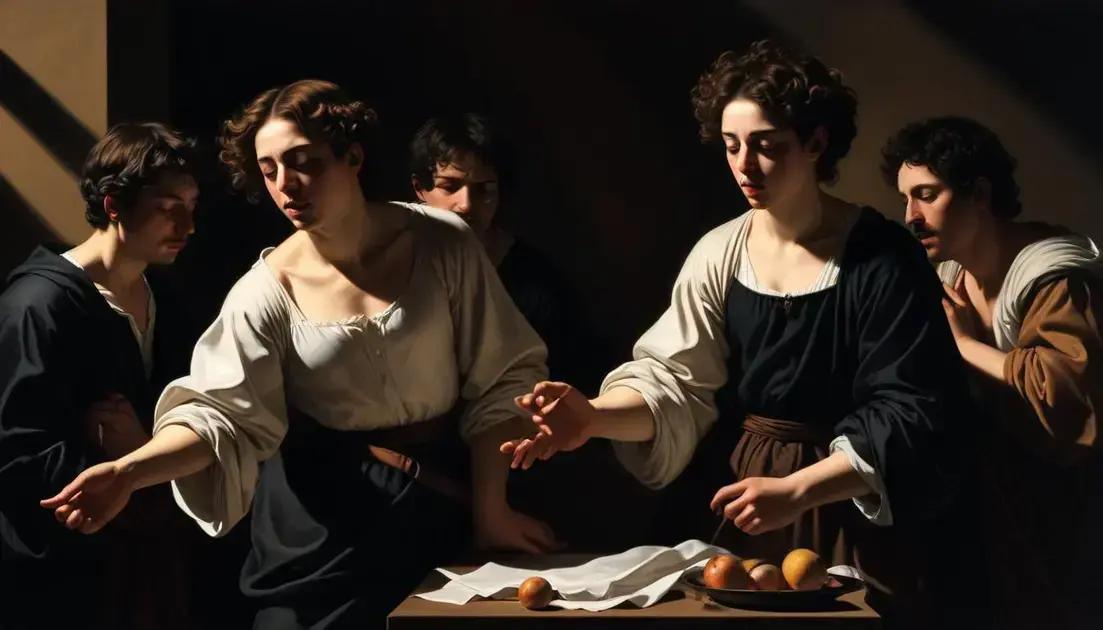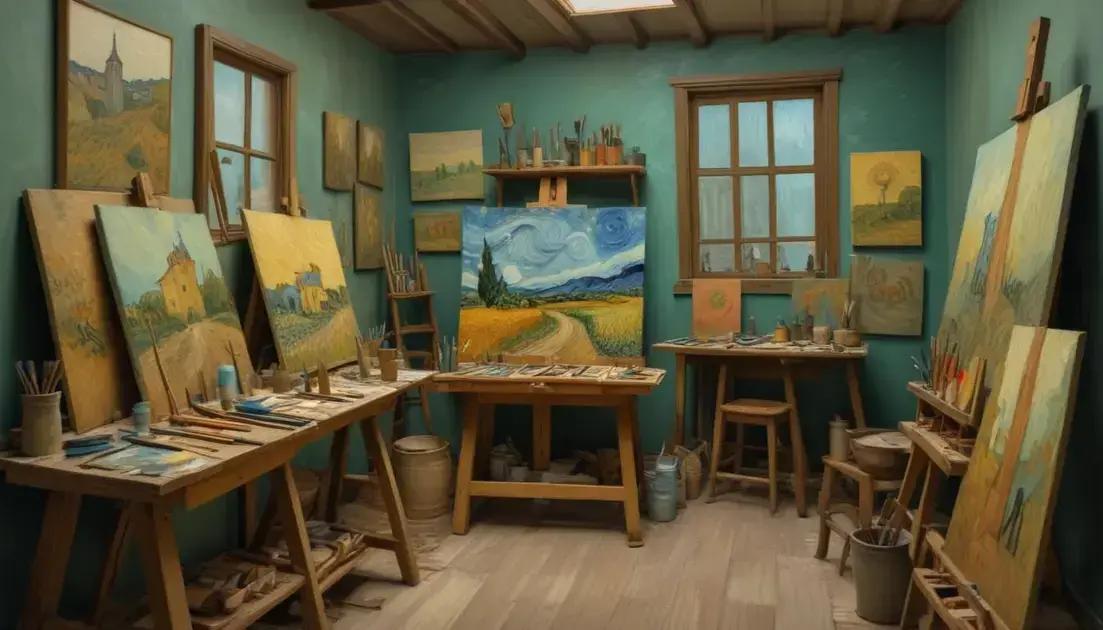
Caravaggio: Light and Shadow of Italian Baroque
Caravaggio, a pivotal figure in the Baroque art movement, is renowned for his dramatic use of light and shadow known as chiaroscuro. His paintings, featuring everyday subjects depicted with raw emotion, broke from traditional representations, influencing countless artists over the centuries. Works like ‘Judith Beheading Holofernes’ and ‘The Calling of Saint Matthew’ are celebrated for their storytelling and emotional depth. Caravaggio’s legacy endures in modern art, inspiring filmmakers and artists who continue to explore themes of realism and human experience.
When you think of the dramatic flair of the Italian Baroque, you can’t help but think of Caravaggio. His unique use of light and shadow revolutionized art and continues to inspire today.
Introduction to Caravaggio’s life and work
Caravaggio was a famous painter born in Italy in 1571. His real name was Michelangelo Merisi. He grew up in a time when art was changing. Artists were moving away from the old ways and looking for new expressions. Caravaggio captured real emotions, making his art feel alive.
He often used light and shadow to create drama in his paintings. This style is known as chiaroscuro. It helped bring out the emotions in his subjects. Many of his paintings tell stories, inviting viewers to engage with the scenes.
Some of his most famous works include “The Calling of Saint Matthew” and “Judith Beheading Holofernes.” Each piece showcases his talent for capturing intense moments. Caravaggio’s life was as dramatic as his art. He faced many challenges, including run-ins with the law.
Despite his troubles, his influence on art remains strong. Even today, artists are inspired by his techniques and vision. Caravaggio is remembered as a key figure in the Baroque period. His legacy lives on through his breathtaking artwork.
The impact of light and shadow in his paintings
The use of light and shadow is crucial in Caravaggio’s paintings. This technique is known as chiaroscuro. Chiaroscuro creates a strong contrast between light and dark areas. It helps to enhance emotions and depth in the artwork.
In many of Caravaggio’s pieces, you’ll see dramatic lighting that highlights key figures. For example, in “The Calling of Saint Matthew,” the light draws attention to Saint Matthew. This makes the moment feel alive and significant.
Caravaggio’s skillful use of shadow adds a sense of mystery and tension. Shadows can suggest hidden feelings or secrets. They invite viewers to look closer and think deeper about the story being told.
This impactful style set Caravaggio apart from other artists of his time. His way of using light not only changed his work but also influenced many future artists. The emotional depth he created became a defining feature of the Baroque period.
Even today, artists study his techniques to understand the power of light and shadow. Caravaggio’s art remains a master class in how lighting can affect storytelling in visual art.
Analysis of key works and their significance
Caravaggio created many key works that changed the way art was seen. His paintings often tell powerful stories with strong emotions. In “Judith Beheading Holofernes,” Caravaggio presents a dramatic moment. Judith’s strength and determination are clear, making the viewer feel her urgency.
Another important work is “The Supper at Emmaus.” In this painting, the moment of recognition is captured beautifully. The use of light highlights the expressions on the faces of the characters, drawing the viewer into the scene.
Caravaggio’s art is significant for its realism. He painted ordinary people, not just idealized figures. This choice made his subjects relatable. It helped viewers connect more deeply with the narratives presented in his art.
His approach influenced many artists after him. They began to focus on emotion and storytelling. This shift marked a turning point toward modern art. Caravaggio’s works are still studied today for their techniques and emotional depth.
These key pieces demonstrate how Caravaggio’s art goes beyond simple representation. His ability to evoke feelings and depict vivid moments makes him a central figure in the Baroque period.
Comparisons with other Baroque artists
Caravaggio’s work stands out among other Baroque artists. He was known for his unique use of light and shadow to bring scenes to life. While many Baroque artists focused on ideal beauty, Caravaggio chose everyday people as his subjects.
For instance, compare him with Peter Paul Rubens. Rubens favored vibrant colors and dynamic compositions. His characters often appeared heroic and larger than life. In contrast, Caravaggio’s figures looked real and relatable. They experienced pain, joy, and struggle just like us.
Another Baroque artist, Artemisia Gentileschi, also tackled strong subjects. She, like Caravaggio, used dramatic lighting. However, her work often highlighted women in powerful roles. Caravaggio’s approach, meanwhile, focused on everyday moments with raw emotion.
Notably, Caravaggio’s influence can be seen in later artists. The dramatic realism he pioneered inspired many, including Rembrandt. They both shared a passion for capturing human emotion through light.
Overall, Caravaggio helped redefine Baroque art. His distinctive style broke away from the norms. He reinforced the power of storytelling in visual art, making his work timeless and influential.
Legacy and continued influence in modern art
Caravaggio’s legacy continues to shape the world of modern art. His realist style changed how artists viewed their subjects. By focusing on human emotion and everyday life, he made art accessible.
Many modern artists admire Caravaggio’s dramatic lighting. His use of chiaroscuro inspires films and photography today. Directors often mimic his techniques to create mood and tension in their work.
Artists like Vincent van Gogh and Pablo Picasso were influenced by him. Van Gogh admired the way Caravaggio expressed light. Picasso later drew from his dramatic compositions, sparking new styles.
Even in contemporary art, Caravaggio’s impact is clear. Many still explore themes of realism and emotional depth. His approach invites discussions about identity, faith, and morality.
Caravaggio’s works are still studied in art schools. Students learn from his techniques and storytelling methods. They see how he transformed the Baroque period and laid the groundwork for future movements.
In short, Caravaggio’s influence is seen in many aspects of modern art. His ability to connect with viewers remains powerful today.
Conclusion
In conclusion, Caravaggio’s impact on art is immense and lasting. His unique use of light and shadow, along with his focus on real human emotions, reshaped painting for generations. Artists continue to learn from his techniques and storytelling methods, keeping his legacy alive.
By breaking traditional boundaries, Caravaggio opened the door for future movements. His works inspire not just painters, but filmmakers and photographers as well. Even today, we see echoes of his style and themes in modern art and media.
Caravaggio’s art is a powerful reminder that art can reflect real life. His ability to make us feel and connect with his subjects will always resonate. As we explore art, we carry forward the lessons he taught us about emotion, realism, and creativity.


